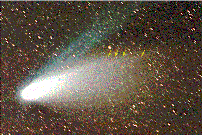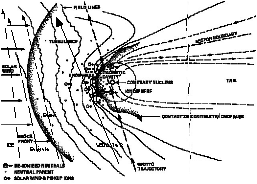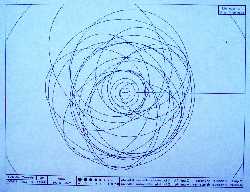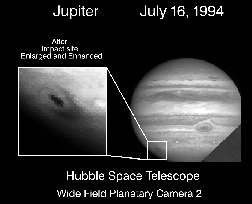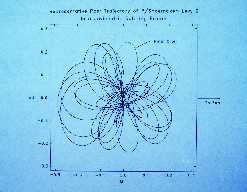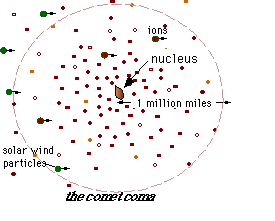Comet Image List
Comets
Hale-Bopp
 (108K GIF)
(108K GIF)
This is a full view of Comet Hale-Bopp. Image provided courtesy of the National Astronomical Observatory of Japan.
Halley
 (1,324K GIF)
(1,324K GIF)
This image shows the ray structure of Halley's Comet. (Courtesy of NASA)
 (68K JPG)
(68K JPG)
This is an image of Comet P/Halley taken with the Halley Multicolor Camera on the ESA mission Giotto. (Courtesy of NASA/NSSDC)
Hyakutake
 (11K JPG)
(11K JPG)
This is a full view of Comet Hyakatuke. Image provided courtesy of Hal Weaver (Applied Research Corp.), HST Comet Hyakutake Observing Team and NASA
 (64K JPG)
(64K JPG)
This shows Comet Hyakatuke on 3/22/96. Image provided courtesy of Night of the Comet and NASA
Linear
 (45K JPG)
(45K JPG)
This image shows Comet Linear brightening when it blew off part of its crust. Image provided courtesy of the Hubble Space Telescope, NASA, and H. Weaver at Johns Hopkins University.
Shoemaker-Levy 9
 (29K JPG)
(29K JPG)
This is an image of Shoemaker-Levy 9 taken with the Wide-Field/Planetary Camera on the Hubble Space Telescope. (Courtesy of NASA/NSSDC and the Space Telescope Science Institute)
 (84K GIF)
(84K GIF)
This sequence shows the A impact of July 16, 1994. (Courtesy of NASA/NSSDC, Tom Herbst, Max-Planck-Institut fuer Astronomie, Heidelberg, Doug Hamilton, Max-Planck-Institut fuer Kernphysik, Heidelberg, Hermann Boehnhardt, Universitaets-Sternewarte, Muenchen, and Jose Luis Ortiz Moreno, Instituto de Astrofisica de Andalucia, Granada)
 (136K GIF)
(136K GIF)
This is an image after the impact of fragment A by the Hubble Space Telescope on July 16, 1994. (Courtesy of NASA/NSSDC)
 (60K GIF)
(60K GIF)
This is a near-infrared image of the G and D impacts on Jupiter taken from the Apache Point Observatory on July 19, 1994. (Courtesy of Mark Marley and Nancy Chanover, Department of Astronomy, New Mexico State University)
 (14K GIF)
(14K GIF)
This is a near-ifrared image showing the sequence of fragment G. (Courtesy of NASA/NSSDC, David Crisp, Vikki Meadows, Stuart Lumsden, Jonathan Pogson, and Steven Lee)
 (108K GIF)
(108K GIF)
This is an infrared color image of the fragment G impact taken on July 18, 1994. (Courtesy of NASA/NSSDC)
 (155K GIF)
(155K GIF)
This is a color image of the fragment G impact site taken by the Hubble Space Telescope. (Courtesy of Hubble Space Telescope Jupiter Imaging Team)
 (53K GIF)
(53K GIF)
This is an infrared color composite showing fragments A, E and F, H and G impacts and the Red Spot on Jupiter. This was taken on July 19, 1994. (Courtesy of NASA/NSSDC)
 (86K GIF)
(86K GIF)
This is an illustration of Comet P/Shoemaker-Levy 9 and Jupiter. (Courtesy of H.A. Weaver, T.E. Smith (Space Telescope Science Institute) and J.T. Trauger, R.W. Evans (Jet Propulsion Laboratory), and NASA/NSSDC)
 (46K GIF)
(46K GIF)
This is a sequence showing the impact of fragment A on Jupiter. (Courtesy of Tom Herbst, Kurt Birkle, Ulrich Thiele, Max Planck Institut fuer Astronomie (Heidelberg, Germany), Doug Hamilton, Max Planck Institut fuer Kernphysik (Heidelberg, Germany), Hermann Boehnhardt, Alex Fiedler, Karl-Heinz Mantel, Universitaets-Sternwarte Muenchen (Muenchen, Germany), Jose Luis Ortiz, Instituto de Astrofisica de Andalucia (CSIC Granada, Spain), Giovanni Calamai, Andrea Richichi, Astrophysical Institute Arcetri (Florence, Italy), and NASA/NSSDC)
Kohoutek
 (228K GIF)
(228K GIF)
This is an image of Comet Kohoutek. (Courtesy of NASA)
Miscellaneous
 (40K GIF)
(40K GIF)
This is a drawing of what the surface of a comet might look like. (Courtesy of JPL)
Missions

This image shows CONTOUR breezing past a comet nucleus (artist's rendition). (Courtesy of NASA)
 (14K JPG)
(14K JPG)
An artist's conception of Deep Space 1. (Courtesy of NASA)

This is a picture of the Giotto spacecraft. (Courtesy of NASA)
Go back to Mars , Pluto, Mercury, Saturn, Neptune, Venus , Moon , Earth, Asteroids, Jupiter , Sun , Missions, Uranus, Astrophysical Objects







